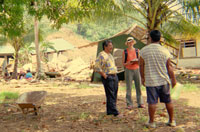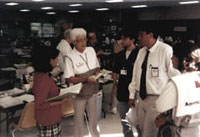Surveillance
Surveillance is the systematic collection, analysis, and interpretation of deaths, injuries, and illnesses in order to provide information about any adverse health effects related to a disaster event in a community.
Surveillance allows us to:
- Assess the human health impacts of a disaster;
- Evaluate potential problems related to planning and prevention.
Examples of CDC activities in surveillance:
- Landslides, Chuuk, Federated States of Micronesia - 2002
- Tropical Storm Allison - 2001
- Flooding in North Dakota - 2000
- Hurricane Georges, Puerto Rico - 1998
- Flooding in Louisiana - 1995
- Passive Surveillance, American Red Cross-CDC Health Impact Surveillance System for Disasters.
 Epidemiologist
Stacy Young interviews a survivor of massive landslides in Chuuk
State, August 2002.
Epidemiologist
Stacy Young interviews a survivor of massive landslides in Chuuk
State, August 2002. The
CDC team discusses the Health Impact Surveillance System for Disasters
with health services staff from the American Red Cross during disaster
operations for Hurricane Fran in North Carolina, September 1996.
The
CDC team discusses the Health Impact Surveillance System for Disasters
with health services staff from the American Red Cross during disaster
operations for Hurricane Fran in North Carolina, September 1996.
Rapid Needs Assessment
Rapid needs assessment refers to a set of tools designed to provide, quickly and at low cost, accurate and reliable population-based information to emergency managers. The objective is to obtain information about the needs of an affected community as these needs change in the aftermath of a disaster event.
Examples of CDC activities in rapid needs assessment:
- Tropical Storm Allison, Texas - 2001
- Hurricane Mitch: Honduras, Nicaragua, Guatemala, El Salvador - 1999
- Earthquake, Turkey - 1999
- Hurricane Georges, Dominican Republic - 1998



